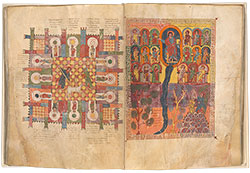
Ms. written and illuminated in Spain, in San Salvador de Tábara, ca. 945.
Texts: Beatus, Presbyter of Liebana, In Apocalipsin (fols. 1-233); Isidore of Seville, De adfinitatibus et gradibus (fols. 234-237); St. Jerome, Commentary on Daniel (fols. 238v-292v); an anonymous discussion of the Apocalypse and comments on Beatus's work (fols. 294-299). According to the colophon (fol. 293) Maius was both the scribe and the illuminator, and executred the work at the command of the Abbot of the Monastery of St. Michael.
Scribe: Maius (died at Tábara in 968)
Decoration: 68 full-page miniatures, 48 smaller miniatures; diagrams, colored initials, and ornaments; Spanish Mozarabic style.
Artist: Maius (died at Tábara in 968)


St. Beatus of Liébana completed his commentary about 776. The long cycles of pictures accompanying it constitute the greatest achievement of medieval Spanish illumination. The Morgan Beatus is important because it is the earliest complete copy and thus stands at the beginning of the Beatus tradition. Although the book was ordered for Escalada (consecrated in 913), it was not made there, as Maius worked in the tower scriptorium at San Salvador de Tábara, where he died and was buried in 968. Maius tells us he made the book so that the "wise may fear the coming of the future judgment of the world's end."
The Apocalypse, or Book of Revelation, is not only the last Book of the New Testament but is also the most difficult, puzzling, and terrifying. According to the text, it was written on the island of Patmos by a man named John, who, from the second century, was traditionally identified with the "beloved" apostle of Christ and the author of the fourth Gospel.
Beatus was a monk of the Liébanese monastery San Martín de Turieno in northern Spain. He completed his twelve-book Commentary on the Apocalypse about 776. The long cycles of pictures accompanying this commentary, of which about twenty illustrated copies survive, constitute the greatest achievement of medieval Spanish illumination. The present manuscript is the earliest substantially complete copy, dating about 950. The colophon states that it was written and illuminated by an artist-scribe named Maius at the request of Abbot Victor for a monastery of St. Michael. This is probably the monastery at Escalada, consecrated in 913. Maius, however, apparently worked in the scriptorium of San Salvador de Tábara, where he died in 968 and was buried. Although he based his copy on a now lost model, Maius also made important contributions of his own, such as the prefatory evangelists' portraits, genealogical tables, and especially the frames and colored backgrounds. He was regarded by his student as "archipictor," master painter. The manuscript contains 110 miniatures, including some illustrating Jerome's Commentary on Daniel, a second text frequently attached to the Beatus commentary. This text can also be found in the Library's later Beatus, dated 1220.
Following the ominous and threatening depictions of the end of the world comes this representation of the Heavenly Jerusalem as a medieval city, complete with turrets and crenelations. In its twelve gates, topped by horseshoe arches derived from Islamic architecture, apostles stand beneath disks representing the gems that are cited in the biblical text. Within the walls of the city itself are the Lamb of God, the author John holding a book, and the angel measuring the city with a golden reed.